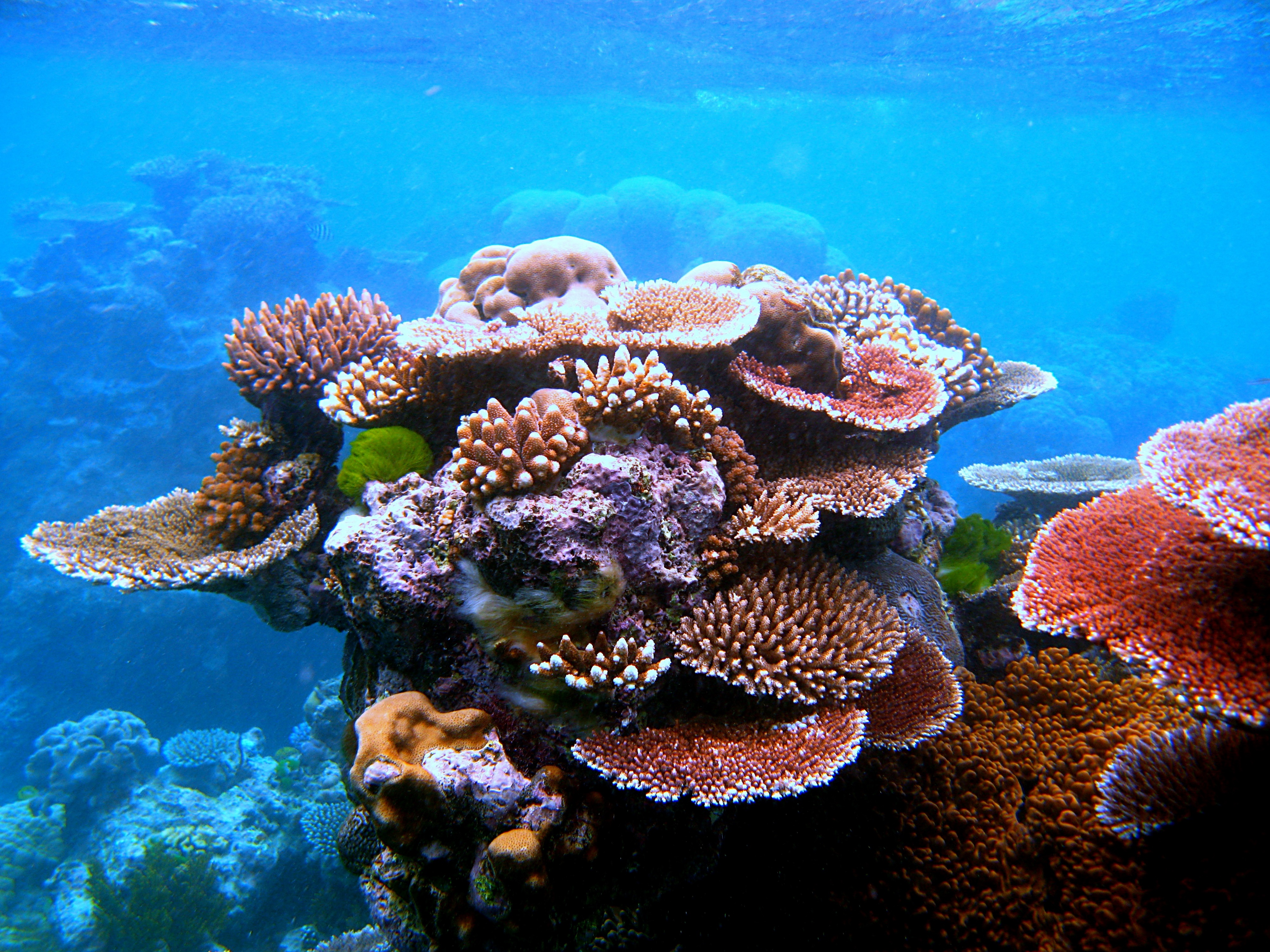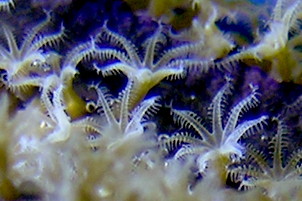|
Corallite
A corallite is the skeletal cup, formed by an individual stony coral polyp, in which the polyp sits and into which it can retract. The cup is composed of aragonite, a crystalline form of calcium carbonate, and is secreted by the polyp. Corallites vary in size, but in most colonial corals they are less than in diameter. The inner surface of the corallite is known as the calyx. The vertical blades inside the calyx are known as septa and in some species, these ridges continue outside the corallite wall as costae In vertebrate anatomy, ribs ( la, costae) are the long curved bones which form the rib cage, part of the axial skeleton. In most tetrapods, ribs surround the chest, enabling the lungs to expand and thus facilitate breathing by expanding the c .... Where there is no corallite wall, the blades are known as septocostae. The septa, costae and septocostae may have ornamentation in the form of teeth and may be thick, thin or variable in size. Sometimes there are paliform l ... [...More Info...] [...Related Items...] OR: [Wikipedia] [Google] [Baidu] |
Scleractinia
Scleractinia, also called stony corals or hard corals, are marine animals in the phylum Cnidaria that build themselves a hard skeleton. The individual animals are known as polyps and have a cylindrical body crowned by an oral disc in which a mouth is fringed with tentacles. Although some species are solitary, most are colonial. The founding polyp settles and starts to secrete calcium carbonate to protect its soft body. Solitary corals can be as much as across but in colonial species the polyps are usually only a few millimetres in diameter. These polyps reproduce asexually by budding, but remain attached to each other, forming a multi-polyp colony of clones with a common skeleton, which may be up to several metres in diameter or height according to species. The shape and appearance of each coral colony depends not only on the species, but also on its location, depth, the amount of water movement and other factors. Many shallow-water corals contain symbiont unicellular organism ... [...More Info...] [...Related Items...] OR: [Wikipedia] [Google] [Baidu] |
Coral Polyp
Corals are marine invertebrates within the class Anthozoa of the phylum Cnidaria. They typically form compact colonies of many identical individual polyps. Coral species include the important reef builders that inhabit tropical oceans and secrete calcium carbonate to form a hard skeleton. A coral "group" is a colony of very many genetically identical polyps. Each polyp is a sac-like animal typically only a few millimeters in diameter and a few centimeters in height. A set of tentacles surround a central mouth opening. Each polyp excretes an exoskeleton near the base. Over many generations, the colony thus creates a skeleton characteristic of the species which can measure up to several meters in size. Individual colonies grow by asexual reproduction of polyps. Corals also breed sexually by spawning: polyps of the same species release gametes simultaneously overnight, often around a full moon. Fertilized eggs form planulae, a mobile early form of the coral polyp which, when m ... [...More Info...] [...Related Items...] OR: [Wikipedia] [Google] [Baidu] |
Astrangia Danae
''Astrangia poculata'', the northern star coral or northern cup coral, is a species of non-reefbuilding stony coral in the family Rhizangiidae. It is native to shallow water in the western Atlantic Ocean and the Caribbean Sea. It is also found on the western coast of Africa. The International Union for Conservation of Nature lists this coral as being of "least concern". ''Astrangia poculata'' is an emerging model organism for corals because it harbors a facultative photosymbiosis, is a calcifying coral, and has a large geographic range. Research on this emerging model system is showcased annually by the Astrangia Research Working Group, collaboratively hosted by Roger Williams University, Boston University, and Southern Connecticut State University Description ''Astrangia poculata'' grows in small clumps that are up to across. The individual polyps are large and sit in stony cups known as corallites. The polyps are translucent and the colony has a furry appearance when they ... [...More Info...] [...Related Items...] OR: [Wikipedia] [Google] [Baidu] |
Septum (coral)
In corals, a septum (plural septa) is one of the radiating vertical plates lying within the corallite wall. Outside the corallite wall these plates are known as costae In vertebrate anatomy, ribs ( la, costae) are the long curved bones which form the rib cage, part of the axial skeleton. In most tetrapods, ribs surround the chest, enabling the lungs to expand and thus facilitate breathing by expanding the c ... (singular costa). The septa may be thick, thin or vary in size. They may have teeth which range from needle-like to blade-like and are often characteristic of different genera. References {{reflist Cnidarian anatomy ... [...More Info...] [...Related Items...] OR: [Wikipedia] [Google] [Baidu] |
Coenosteum
In corals, the coenosteum is the stony skeletal material secreted by the coenosarc, the layer of living material lying between the corallites (the stony cups in which the polyps sit). The coenosteum is composed of aragonite Aragonite is a carbonate mineral, one of the three most common naturally occurring crystal forms of calcium carbonate, (the other forms being the minerals calcite and vaterite). It is formed by biological and physical processes, including pre ..., a crystalline form of calcium carbonate, and is generally a spongy, porous material. Sometimes the coenosteum has ornamentation such as ridges and beads, visible as raised areas of the coenosarc. The coenosteum and corallites together are known as the corallum. References {{reflist Cnidarian anatomy ... [...More Info...] [...Related Items...] OR: [Wikipedia] [Google] [Baidu] |
Costa (coral)
In corals, a costa (plural costae) is one of the vertical plates lying outside the corallite wall, a continuation of a septum In biology, a septum (Latin for ''something that encloses''; plural septa) is a wall, dividing a cavity or structure into smaller ones. A cavity or structure divided in this way may be referred to as septate. Examples Human anatomy * Interat ... (plural septa) which lies inside the wall. The costae may continue to the edge of the colony and in solitary species, such as those in the family Fungiidae, refers to the ridges on the underside of the coral. References {{reflist Cnidarian anatomy ... [...More Info...] [...Related Items...] OR: [Wikipedia] [Google] [Baidu] |
Mesentery (zoology)
In zoology, a mesentery is a membrane inside the body cavity of an animal. The term identifies different structures in different phyla: in vertebrates it is a double fold of the peritoneum enclosing the intestines; in other organisms it forms complete or incomplete partitions of the body cavity, whether that is the coelom or, as in the Anthozoa, the gastrovascular cavity. The word "mesentery" is derived from the Greek ''mesos'', "in the middle" and ''enteron'', an "intestine". Vertebrates In vertebrates, a mesentery is a membrane consisting of a double fold of peritoneum that encloses the intestines and their associated organs and connect them with the dorsal wall of the abdominal cavity. In invertebrates, a mesentery is a support or partition in a body cavity serving a similar function to the mesenteries of vertebrates. Bilateria In bilaterally symmetrical organisms there is often a major mesentery separating the two halves of the coelom. In segmented organisms such as eart ... [...More Info...] [...Related Items...] OR: [Wikipedia] [Google] [Baidu] |
Coenosarc
In corals, the coenosarc is the living tissue overlying the stony skeletal material of the coral. It secretes the coenosteum, the layer of skeletal material lying between the corallites (the stony cups in which the polyps sit). The coensarc is composed of mesogloea between two thin layers of epidermis and is continuous with the body wall of the polyps. The coenosarc contains the gastrovascular canal system that links the polyps and allow them to share nutrients and symbiotic zooxanthellae Zooxanthellae is a colloquial term for single-celled dinoflagellates that are able to live in symbiosis with diverse marine invertebrates including demosponges, corals, jellyfish, and nudibranchs. Most known zooxanthellae are in the genus '' .... References {{reflist Cnidarian anatomy ... [...More Info...] [...Related Items...] OR: [Wikipedia] [Google] [Baidu] |
Polyp (zoology)
A polyp in zoology Zoology ()The pronunciation of zoology as is usually regarded as nonstandard, though it is not uncommon. is the branch of biology that studies the animal kingdom, including the structure, embryology, evolution, classification, habits, and ... is one of two forms found in the phylum Cnidaria, the other being the medusa (biology), medusa. Polyps are roughly cylindrical in shape and elongated at the axis of the vase-shaped body. In solitary polyps, the aboral (opposite to oral) end is attached to the substrate (biology), substrate by means of a disc-like holdfast (biology), holdfast called a pedal disc, while in colony (biology), colonies of polyps it is connected to other polyps, either directly or indirectly. The oral end contains the mouth, and is surrounded by a circlet of tentacles. Classes In the class (biology), class Anthozoa, comprising the sea anemones and corals, the individual is always a polyp; in the class Hydrozoa, however, the indi ... [...More Info...] [...Related Items...] OR: [Wikipedia] [Google] [Baidu] |
Aragonite
Aragonite is a carbonate mineral, one of the three most common naturally occurring crystal forms of calcium carbonate, (the other forms being the minerals calcite and vaterite). It is formed by biological and physical processes, including precipitation from marine and freshwater environments. The crystal lattice of aragonite differs from that of calcite, resulting in a different crystal shape, an orthorhombic crystal system with acicular crystal. Repeated twinning results in pseudo-hexagonal forms. Aragonite may be columnar or fibrous, occasionally in branching helictitic forms called ''flos-ferri'' ("flowers of iron") from their association with the ores at the Carinthian iron mines. Occurrence The type location for aragonite is Molina de Aragón in the Province of Guadalajara in Castilla-La Mancha, Spain, for which it was named in 1797. Aragonite is found in this locality as cyclic twins inside gypsum and marls of the Keuper facies of the Triassic. This type of ... [...More Info...] [...Related Items...] OR: [Wikipedia] [Google] [Baidu] |
Colony (biology)
In biology, a colony is composed of two or more conspecific individuals living in close association with, or connected to, one another. This association is usually for mutual benefit such as stronger defense or the ability to attack bigger prey. Colonies can form in various shapes and ways depending on the organism involved. For instance, the bacterial colony is a cluster of identical cells (clones). These colonies often form and grow on the surface of (or within) a solid medium, usually derived from a single parent cell. Colonies, in the context of development, may be composed of two or more unitary (or solitary) organisms or be modular organisms. Unitary organisms have determinate development (set life stages) from zygote to adult form and individuals or groups of individuals (colonies) are visually distinct. Modular organisms have indeterminate growth forms (life stages not set) through repeated iteration of genetically identical modules (or individuals), and it can be diffi ... [...More Info...] [...Related Items...] OR: [Wikipedia] [Google] [Baidu] |





